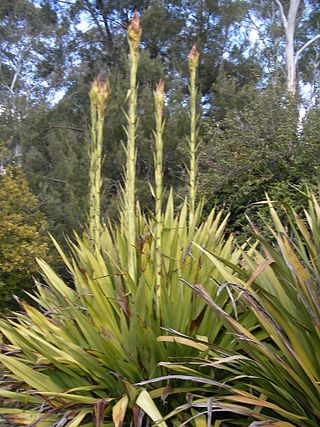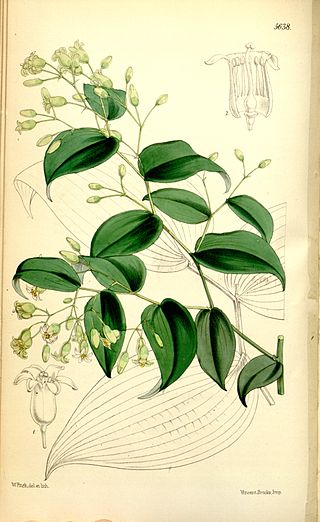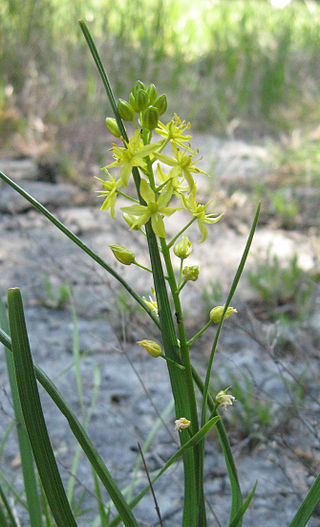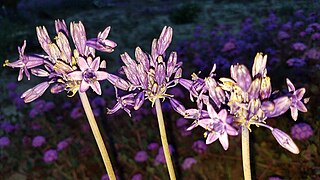
Brodiaea, also known by the common name cluster-lilies, is a monocot genus of flowering plants.

Milla, the Mexican star, is a genus of monocotyledonous plants in the family Asparagaceae, subfamily Brodiaeoideae. They are native mostly to Mexico, with one species extending into Guatemala, Honduras, Arizona, Texas and New Mexico.

Brodiaeoideae are a monocot subfamily of flowering plants in the family Asparagaceae, order Asparagales. They have been treated as a separate family, Themidaceae. They are native to Central America and western North America, from British Columbia to Guatemala. The name of the subfamily is based on the type genus Brodiaea.

Maianthemum includes the former genus Smilacina and is a genus of perennial herbaceous flowering plants with fleshy, persistent rhizomes. It is widespread across much of North America, Europe and Asia, and may be terrestrial, aquatic or epiphytic. It is characterized by simple, unbranched stems that are upright, leaning or hanging down and have 2–17 foliage leaves. Leaves are simple and may clasp the stem or be short-petiolate. The inflorescence is terminal and either a panicle or a raceme with few to many pedicelate flowers. Most species have 6 tepals and 6 stamens; a few have parts in 4s. Tepals are distinct in most species and all of similar size. Flowers are spreading, cup-shaped or bell-shaped and usually white, but lavender to red or green in some species. Fruits are rounded to lobed berries containing few to several seeds.

Asparagaceae, known as the asparagus family, is a family of flowering plants, placed in the order Asparagales of the monocots. The family name is based on the edible garden asparagus, Asparagus officinalis. This family includes both common garden plants as well as common houseplants. The garden plants include asparagus, yucca, bluebell, and hosta, and the houseplants include snake plant, corn cane, spider plant, and plumosus fern.

Aphyllanthes is a genus of flowering plants with only one species, Aphyllanthes monspeliensis, endemic to the western Mediterranean region. It is the only genus in the Aphyllanthoideae, a subfamily of the family Asparagaceae. Aphyllanthoideae was formerly treated as a separate family, Aphyllanthaceae.

Doryanthes is the sole genus in the flowering plant family Doryanthaceae. The genus consists of two species, D. excelsa and D. palmeri, both endemic natives of the coast of Eastern Australia. Doryanthaceae is part of the order Asparagales.

Brodiaea orcuttii is a species of flowering plant in the family Asparagaceae, within the subfamily Brodiaeoideae. It is a cluster-lily known by the common name Orcutt's brodiaea. This corm-sprouting species is nearly endemic to San Diego County, with the periphery of its range reaching the southern portion of Riverside County along with some populations sparsely scattered in northwestern Baja California. Brodiaea orcuttii is usually associated with the marginal areas of vernal pools, seeps, meadows, and stream embankments, microhabitats which can generally be found from coastal mesas to interior mountains. The red-purple to blue flowers bloom from April to July. It can be distinguished from all other species of Brodiaea by its lack of staminodes.

Behnia is a genus of flowering plants. In the APG III classification system, it is placed in the family Asparagaceae, subfamily Agavoideae. There is only one known species, Behnia reticulata, a climber plant native to southern Africa.

Schoenolirion, rush-lily or sunnybell, is a genus of three recognized species of flowering plants, all endemic to the southeastern United States. In the APG III classification system, the genus is placed in the family Asparagaceae, subfamily Agavoideae.

Hemiphylacus is a genus of flowering plants endemic to Mexico. In the APG III classification system, it is placed in the family Asparagaceae, subfamily Asparagoideae.
Dandya is a genus of about four species of flowering plants, all endemic to Mexico. In the APG III classification system, it is placed in the asparagus family, and the cluster lily subfamily.
- Dandya balsensisA.R.López-Ferrari & Espejo - central and southern Mexico
- Dandya hannibaliiL.W.Lenz - Michoacán
- Dandya purpusii(Brandegee) H.E.Moore - Coahuila
- Dandya thadhowardiiL.W.Lenz - Michoacán, Guerrero

Triteleiopsis, common name Bajalily or blue sand lily, is a genus of one known species of flowering plant found in Sonora, Baja California and southwestern Arizona. In the APG III classification system, it is placed in the family Asparagaceae, subfamily Brodiaeoideae.

Speirantha is a genus of one known species of flowering plants found in south-east China. In the APG III classification system, it is placed in the family Asparagaceae, subfamily Nolinoideae.
Dichromanthus yucundaa is a terrestrial species of orchid. It is endemic to the State of Oaxaca in southern Mexico.

Xochiquetzallia is a genus of geophytic flowering plants of the subfamily Brodiaeoideae in the family Asparagaceae. The genus contains four species: three previously classified within the genus Dandya and one other previously classified within Milla. Earlier genetic and morphological research had shown that the broad Milla clade of plants is made up of two sister lineages. The four plant species now within Xochiquetzallia make up one of these lineages, and are more closely related to each other than they are to the second lineage, which is made up of the remaining Milla species, Dandya purpusii, and the genera Behria, Bessera, Jaimehintonia and Petronymphe. Jorge Gutiérrez and Teresa Terrazas, two of the botanists who worked on the earlier research, followed up in 2020 with a paper formally transferring the four species from Dandya and Milla to Xochiquetzallia.

Beaucarnea stricta is a tree in the family Asparagaceae, native to Mexico. The specific epithet stricta means "straight, thin", referring to the leaves.
Beaucarnea olsonii is a plant in the family Asparagaceae, native to Mexico. The species is named for the botanist Mark E. Olson.
Beaucarnea sanctomariana is a tree in the family Asparagaceae, native to Mexico. The species is named for the town of Santa María Chimalapa in Oaxaca.
Beaucarnea purpusii is a tree in the family Asparagaceae, native to Mexico. It grows up to 8 metres (30 ft) tall.















